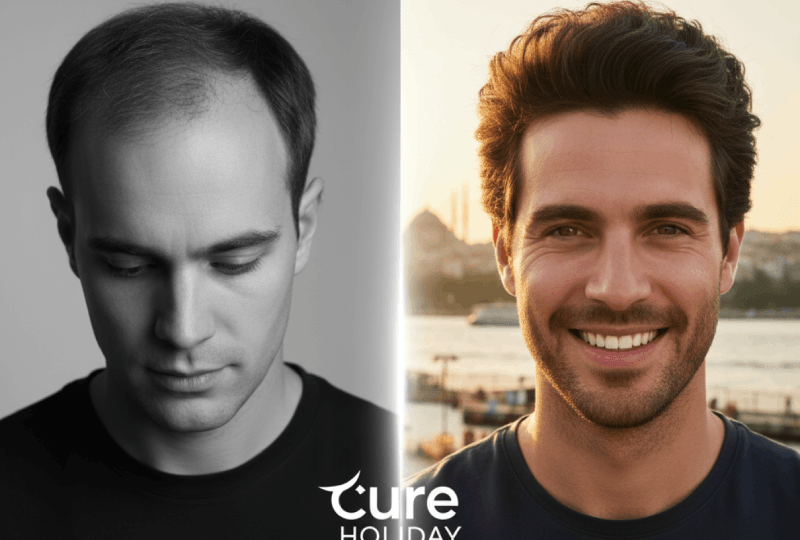Biological and Genetic Basis of Hair Transplant Permanence
The success and permanence of a hair transplant rely on a fundamental biological principle: the genetic memory of hair follicles. In individuals experiencing hair loss, the primary cause of shedding is the genetic sensitivity of hair follicles to the dihydrotestosterone (DHT) hormone. This hormone weakens the hair follicles, causing them to thin and eventually fall out.
The basic principle of hair transplantation is to harvest hair follicles from areas that are genetically resistant to this hormone and transplant them to bald or thinning areas. The back of the head and the nape are typically chosen as the primary donor areas due to their high hair density and the presence of follicles that are genetically resistant to shedding. In some cases, the beard or chest area, which also contains stronger follicles, may be used as a donor site.
Even after being relocated to their new site, the transplanted hair follicles retain their original genetic characteristics. This keeps them resistant to the effects of the DHT hormone that causes hair loss, thus ensuring the transplanted hair lasts a lifetime. This is the most important indicator that hair transplant surgery is not just a cosmetic procedure but a permanent biological solution. Additionally, using the person’s own hair follicles eliminates the risk of immunological rejection by the body. However, this principle also highlights the fact that the amount of hair in the donor area is limited, emphasizing the importance of preserving the donor area for potential future needs.
Post-Operative Period: The “Shock Loss” Phenomenon
One of the biggest concerns for many hair transplant recipients is when the transplanted hair starts to fall out a few weeks after the operation. This is a temporary and completely normal stage of the hair transplant process, known as “shock loss.” Shock loss occurs because the hair follicles temporarily enter the resting phase (telogen phase) due to the stress and trauma experienced during the transplantation procedure.
What falls out during this process is only the hair shaft, not the hair root (follicle) itself; the hair root remains intact and permanent in its new location. This shedding is a sign that the follicle is healing and preparing to produce a new, healthy hair shaft. It typically begins 1 to 5 weeks after the hair transplant and stops within about 2 weeks, although this can vary from person to person. It is considered normal for 70% to 80% of the transplanted hair strands to shed during this phase. Experiencing shock loss is not a sign of failure but is, in fact, a natural part of the hair transplant process and should be met with patience.
Long-Term Growth Cycle and Timeline for Success
To evaluate the final outcome of a hair transplant operation, it is vital to understand the biological growth cycle of hair and to be patient. The hair growth cycle consists of three main phases: Anagen (growth), Catagen (transition), and Telogen (resting/shedding). The hair transplant procedure causes the transplanted follicles to enter the resting phase, leading to shock loss. After this phase, the follicles re-enter the active growth phase.
The post-operative process can be summarized with the following stages:
- First 3 months: Shock loss occurs, and no significant progress is seen in the transplanted area. This is a passive period.
- After the 3rd month: The hair follicles slowly begin to grow. The first hairs to emerge may have a non-straight, coarse form known as “curly hair syndrome.”
- 6 to 9 months: A noticeable increase in hair density and thickness is observed, and about 60% of the final result is achieved.
- 9 to 12 months: New hairs continue to grow and thicken. During this period, approximately 80% of the final result is obtained.
- 12 to 24 months: The hair reaches its full form, matures, and becomes completely thick. This process can take up to 24 months, especially in areas like the crown where blood circulation is less prominent.
Minimizing Risks: Why Hair Transplants Fail and How to Prevent It
A successful hair transplant operation depends on both the expertise of the surgical team and the patient’s post-operative care responsibilities. Although the operation offers a scientifically and clinically permanent solution, some factors can negatively impact the process.
1. Inexperienced Clinic and Doctor: One of the most significant reasons for failure is an inexperienced doctor or an unlicensed clinic. An inexperienced team may fail to choose an appropriate donor area, properly harvest and store the grafts, or demonstrate sufficient precision during the transplantation. Over-harvesting the donor area can also lead to an aesthetic failure, resulting in a patchy and sparse appearance at the nape.
2. Not Being a Suitable Candidate: Not every individual is a suitable candidate for a hair transplant. The absence of a sufficient number of healthy donor hair follicles can prevent a successful and dense result. Additionally, if a person whose hair loss process is still ongoing undergoes the operation, the transplanted hairs may appear like a “lonely island” as the surrounding existing hair continues to shed, even if the transplanted hairs are permanent.
3. Insufficient Post-Operative Care: Post-operative care is just as important as the surgery itself. Failure to follow the given instructions, incorrect washing techniques, excessive sweating, and the consumption of cigarettes and alcohol can prevent the transplanted follicles from taking hold in their new location and can lead to graft loss. Alcohol can hinder the necessary blood flow to the hair follicles due to its blood-thinning effect, while smoking can constrict blood vessels, preventing cells from getting enough oxygen and slowing down the healing process.
Pillars of Success: Comprehensive Care and Supportive Treatments
Post-operative care and supportive treatments play a critical role in ensuring the healthy and strong growth of transplanted hairs and maintaining their permanence.
1. Immediate Post-Operative Care: The first 10 days after the operation are the most sensitive stage of the healing process. The first wash is usually performed by an expert team on the second or third day after the operation. Afterward, patients must gently wash their hair with special lotions and shampoos provided, avoiding excessive pressure and rubbing motions. The hair should be allowed to air dry instead of using a towel or a hairdryer. During this period, utmost attention should be paid to hygiene rules to minimize the risk of infection, and prescribed medications should be used regularly.
2. Hair-Strengthening Medications and Supplements: Some medications used after a hair transplant aim to protect the health of existing hairs that have the potential to continue shedding, not the transplanted ones. Minoxidil can increase hair density in both men and women by extending the hair growth cycle and delaying hair loss. Similarly,
Finasteride lowers DHT levels, which is the primary cause of male pattern baldness, thus protecting and strengthening existing hairs. The regular use of these medications is important for the long-term preservation of the aesthetic result achieved with hair transplantation. Additionally, nutritional supplements like
Biotin, zinc, and B vitamins can also help strengthen hair follicles and accelerate the growth of new hairs.
3. Advanced Supportive Treatments: Treatments such as PRP (Platelet-Rich Plasma) and Mesotherapy are supportive methods that increase the success of hair transplantation. In
PRP therapy, platelet-rich plasma obtained from the patient’s own blood contains growth factors and healing proteins. This plasma is injected into the transplanted area to increase the grafts’ ability to take hold, accelerate tissue repair, and strengthen hair follicles.
Mesotherapy, on the other hand, encourages blood circulation and hair growth by injecting vitamins, minerals, and growth factors into the scalp with micro-needles. These supportive treatments act as a catalyst to strengthen the final outcome of the operation.
Overview of Modern Hair Transplant Techniques
Today, the most commonly used hair transplant techniques are FUE and DHI. Both methods have the potential to provide permanent and successful results, but their application methods and usage areas differ. FUT (Follicular Unit Transplantation) is an older technique, but it may still be preferred in certain situations.
FUE (Follicular Unit Extraction): In this modern technique, hair follicles are harvested one by one using a special micromotor or a manual punch device. The harvested grafts are then placed into pre-prepared channels before implantation. The
FUE method is more suitable for transplanting large bald areas, and an average of 4,000 grafts can be transplanted in a single session. As a minimally invasive procedure, it leaves no noticeable scarring in the donor area, and the recovery time is shorter.
DHI (Direct Hair Implantation): The DHI method uses a special medical pen called a Choi Pen. This pen performs the harvesting and direct implantation of hair follicles simultaneously, which eliminates the channel-opening stage. DHI is preferred for sensitive and narrow areas like the frontal hairline to achieve a denser and more natural look. The operation time may be longer, but the healing process is generally shorter, and there is less bleeding.
FUT (Follicular Unit Transplantation): In FUT, an older method, a strip of skin is removed from the donor area, and the hair follicles are separated from this strip. While this method has the advantage of providing more grafts in a single session and is generally more economical, it carries the risk of leaving a permanent stitch scar in the donor area, and the healing time is longer.
The following table compares the main features of the FUE and DHI methods:
| Criterion | FUE (Follicular Unit Extraction) | DHI (Direct Hair Implantation) |
| Graft Harvesting | One by one with a micromotor or punch | One by one with a Choi Pen |
| Implantation Method | Placing into pre-opened channels | Direct implantation with a Choi Pen |
| Shaving Requirement | Donor area is generally shaved | Can generally be done without shaving |
| Recovery Time | Relatively longer | Faster |
| Scarring | Pinpoint scars, usually invisible | Lower risk of scarring |
| Grafts per Session | Suitable for wide areas, 4000+ grafts | Suitable for narrow areas, 1500-2000 grafts |
| Naturalness | Natural result with channels opened at the correct angle | More precise angles and density with the Choi Pen |
Conclusion: The Path to Success
The permanence of hair transplantation depends on the chosen clinic and the patient’s post-operative care as much as the operation itself. The answer to the question, “Do transplanted hairs fall out?”, is that after the natural process of shock loss, hair follicles that are transplanted under the right conditions and are genetically resistant will produce new, permanent hair.
The success of a hair transplant operation is possible when a combination of factors comes together. These include choosing an experienced doctor, applying the correct techniques, and, most importantly, meticulously following post-operative care instructions. Avoiding external factors, washing regularly, and using the supportive treatments recommended by the doctor are critical steps for preserving the health of both the transplanted and existing hairs. In conclusion, a hair transplant is not just a surgical procedure but a holistic process that requires patience, care, and expertise.
Unlocking Your Confidence with a Hair Transplant in Turkey: An Exclusive Offer from Cure Holiday
Have you been thinking about getting your hair back, but you’re not sure where to start? A hair transplant can be a life-changing experience, and Turkey has become the number one destination for this popular cosmetic procedure. With advanced techniques and experienced surgeons, it’s easier and more affordable than ever to restore your hair and your confidence.
At Cure Holiday, we specialize in making this journey simple, safe, and stress-free. We believe that everyone deserves to feel their best, and our all-inclusive packages are designed to give you a premium experience without the premium price tag.
Why Choose Cure Holiday?
- Experienced Doctors: Our partner clinics work with some of Turkey’s most skilled and reputable surgeons, ensuring you’re in expert hands from start to finish.
- All-Inclusive Comfort: Forget about the hassle of planning. Our packages cover everything: your flights, 5-star hotel stay, airport transfers, and even a dedicated host to guide you through every step of your treatment.
- Cutting-Edge Techniques: We offer the latest hair transplant methods, including FUE (Follicular Unit Extraction) and DHI (Direct Hair Implantation), giving you natural, permanent results with minimal scarring.
- Unbeatable Value: Thanks to Turkey’s lower operational costs, we can provide world-class quality at a fraction of the price you’d pay in the UK, USA, or Europe.
Your New Look is Closer Than You Think
Ready to take the first step toward a new you? Contact us today for a free consultation. Our team is here to answer all your questions and help you customize a plan that’s perfect for you.
Don’t let another day go by wishing for the hair you used to have. Let Cure Holiday help you get it back, with an exclusive offer you won’t find anywhere else.



